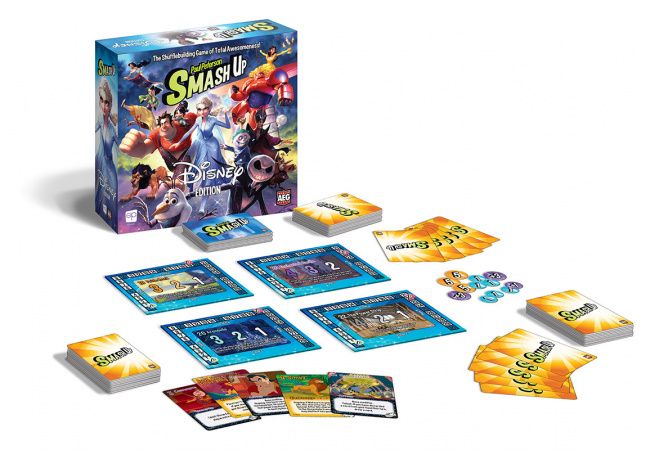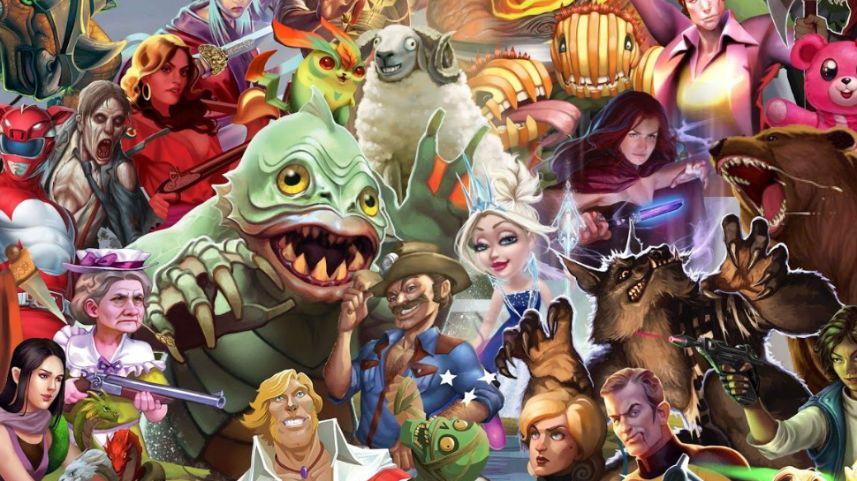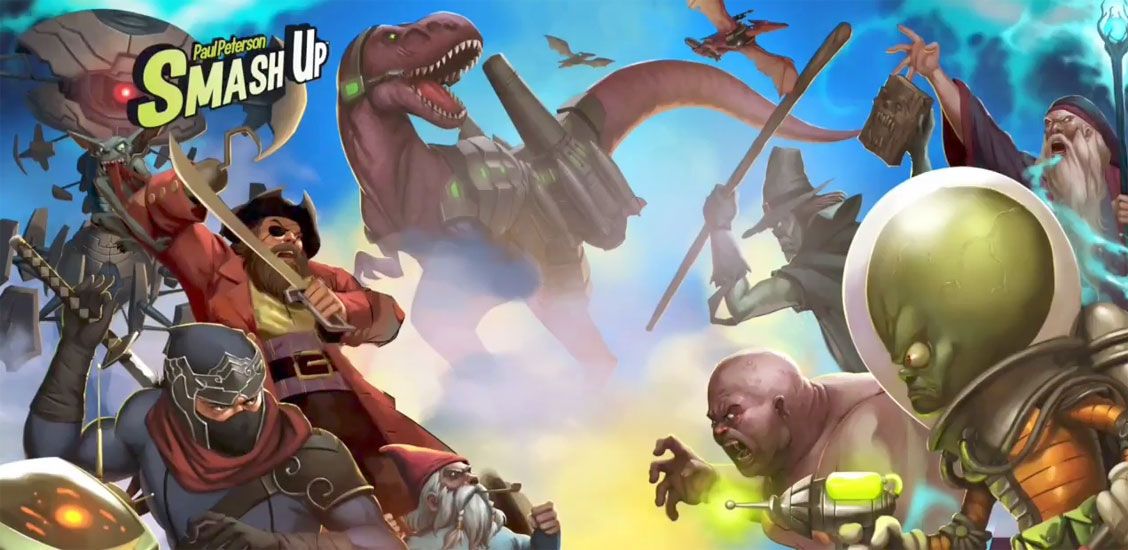You should take the time to learn how to play Smash Up. Everyone loves and still plays this fantastic combat strategy card game from 2012, which has incredibly rich characters and themes. In Smash Up, there’s no limit to the awesomeness you can throw into battle. With crazy card combinations, eye-popping art, and a ruleset designed to get you playing faster than other card games, Smash Up is a favorite amongst casual and heavily-invested gamers alike. You can learn how to play Smash Up by reading this article.
Who Can Play The Board Game Smash Up?
For two to four players, Smash Up features combat. Nothing less than complete world dominance is your aim! Attack enemy bases with your minions. While Smash Up is a combat strategy game, the main hook is that you are “smashing up” two completely different “factions”.
The combinations and synergistic effects are limitless, and you could have wizards and ninjas, pirates and zombies, or aliens and dinosaurs. Since then, many new factions have emerged that undoubtedly improve gameplay, but the original base game will work just fine for you.
Base Game Factions
- ALIENS: Aliens enjoy embarrassing humans and embarrassing other players even more. Aliens are out to have fun at any planet’s expense, whether it’s by bouncing minions back into players’ hands or by replacing bases already in play.
- DINOSAURS: Dinosaurs, with a brain the size of a walnut, isn’t really capable of knowing how to do anything if there is one thing they are. They have lasers, though, and they are big.
- NINJAS: Most likely, you’re already dead if you can see a ninja. The majority of what the faction does is cunning, quick, and last-minute. So look out for that.
- PIRATES: What is more enjoyable than roving the high seas? traveling anywhere you want. Every port has pirates who buckle their swashes, and if you don’t like it, you’ll have to walk the plank.
- ROBOTS: The robots were created by captains of industry, and once they took control, they increased productivity even more! These days, they can produce more tiny, highly specialized bots than their adversaries can handle. Oh, and a few very large ones too.
- TRICKSTERS: You’ve regarded these little people as pests for years because they steal things, stop things from happening, start things from happening, hide your keys when you get up in the morning, and collect underwear for money. They have now been discovered as pesticides.
- WIZARDS: Wizards suddenly conjure what they require with a flurry of actions. You should keep an eye on their hands because they just keep pulling things out of their hats. Or their hats, or the sizable portal to a different reality they just unlocked in your kitchen.
- ZOMBIES: They are headed your way. A skilled walker is challenging to contain. Zombies just keep reappearing, and occasionally they arrive in waves. Zombies will eventually return, so throwing them away is pointless.
Card Clarifications
- AFFECT: A card is impacted if it is moved, returned, destroyed, or has an action associated with it.
- DESTROY: Put the card that was destroyed in its owner’s discard pile whenever a card instructs you to do so.
- DISCARD: No matter who played or controlled a card, when it is discarded, it goes to the discard pile of the player whose deck it originated from.
- EXTRA: Typically, you are allowed to play one minion and one action per turn. You can play an additional card of the same type during the turn if the card you are using allows you to play an extra minion or action. Unless the extra card was obtained through a special ability, you are not required to pay the extra card right away.
- MOVE: By doing this, you can move a card from one place to another. A card cannot be played by moving it. When you move a card, minion abilities do not occur.
- ONGOING: The majority of abilities either take place and then end, or else they do so at the end of the turn. As long as an ability is present, it is in effect.
- PLAY: When a card is one of the free cards you receive in phase 2 or when an ability specifically states that you’re playing it, you play that card. When a card is played, its ability takes effect. The abilities of cards are not activated when they are moved, placed, or returned.
- RETURN: This implies that a card returns to its original location. Discard any attachments on a card when it emerges from a base.
- SPECIAL: The majority of abilities occur when you play a card. When you play a card, special abilities take effect. In unusual ways, special abilities manifest. On a card that is currently in play or in your hand, there may be special abilities. The ability of a card will specify how it can be used. It doesn’t count as one of your free cards for that turn if you play a card during your turn using a special ability.
Game Contents
- 8 factions with 20 cards each
- 16 base cards
- 1 rule book
Can Smash Up Be Enjoyed By The Whole Family?
The game Smash Up isn’t for everyone. We believe the suggested age on the box, which is 12+, to be fairly accurate. Every card has a lot of text on it, and the goal of the game is to maximize your points by strategically planning how to use your cards and abilities.

As Jaden demonstrates in his card game video review, there is a lot going on to keep track of once the Minions start landing on bases and special Actions are played to move Minions around and change things up.
Additionally, players frequently have a variety of options to think about. Therefore, there is a lot of thinking required for a theme that seems fairly absurd and entertaining.
How To Play Smash Up?
The popular card combat strategy board game Smash Up has a detailed instruction manual. Below the lists are additional ideas and unique rules. For your convenience, these will be mentioned.
Setup | Put Out Stacks Of Each Faction
Get the players you’ll be playing with together before you start learning how to play Smash Up. On the table in the middle of everyone put out stacks of cards for each individual “faction”. In the base game (more have been added), the faction symbol is located in the bottom right corner of each card. All cards that match should be placed in one of eight stacks.
Setup | Players Draft Factions
To play, each player needs to “Smash Up” two factions (wizards and samurai for example) and this is done by taking turns picking from what is available. Due to the wheel draft format, if you select a player in the first round, you will select them in the second round, last.
If you are the third person to go, picks #3 and #4 will be awarded to you. When choosing, keep in mind that different factions’ combined effects have different synergistic effects.
Setup | Players Shuffle Decks And Draw
Players combine the two stacks they created after selecting the two distinct factions to create a single deck. They will draw cards from this deck, which is set up in front of them, for the game. To begin, each participant is dealt 5 cards.
Setup | Put Out Base Cards
Separate from the yellow-backed faction cards are the blue-backed “base” cards. These are the objects with three numbers that players attack to earn victory points. Place a number of cards in the middle of the table, one more than the number of players, after shuffling the deck.
The leftovers should be placed to one side, face down. When a base collapses, you must build a new one in its place. The final setup step in the instruction manual for Smash Up is this.

Gameplay | Turn Structure
You must choose a starting participant. Then, with several phases, that player completes an entire turn. Nothing you do will essentially have an impact outside of your turn. After that turn is finished, it is passed to the player to the left, who will then take a full turn, and so on.
Gameplay | Turn Phase 1 – Trigged Abilities
Some playing cards have abilities that start the turn-off. There is no secret here; all of the cards will indicate whether or not they trigger something. Pay close attention because this is a crucial step in learning how to play Smash Up.
Gameplay | Turn Phase 2 – Play Card
There are two categories of cards: actions, which perform unique actions, and minions, which are both creatures and people. While Actions can be anything, the card will specify what it is, Minions are placed on a base of your choosing. You may play up to one of each type during your turn (so none, just one of either, or one of each). You can carry out these steps in any order.
Gameplay | Turn Phase 3 – Scoring Bases
Once the cards have been dealt, see if any bases are available for scoring. This happens if the total power of all the minions (number in the top left corner) is equal to or greater than the “breaking point” of the base (number in the top left corner of the base).
When this occurs, whoever has the most power there receives the highest number (far left), the second-highest receives the middle number, and the least receives the lowest number (far right). There must be at least one power present to qualify, and points are divided into ties.
Gameplay | Turn Phase 4 – Draw 2 New Cards
You pull two fresh cards from your deck during this phase. If you have more than ten cards in your hand, decide which ones to discard in order to get back to ten.
Gameplay | Turn Phase 5 – Final Ability Resolution
The end of the turn has a similar phase where some abilities might activate as it does at the beginning. If any active card specifies that something occurs at the end of the turn, then let it occur right now.
Winning | First To 15 Victory Points
Till someone earns 15 victory points, turns continue to be taken. The player with the most points at the end of that player’s turn after they reach the 15-point mark wins (though it’s likely to be them, anything can happen). Smash Up is generally simple to learn, though there are some subtleties.
Read More: What Is The Stardew Valley Board Game?
